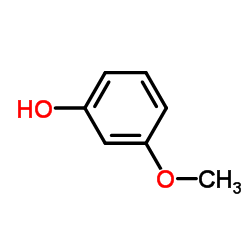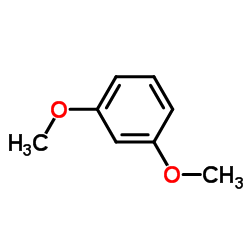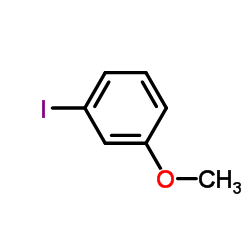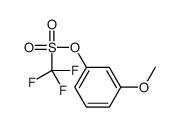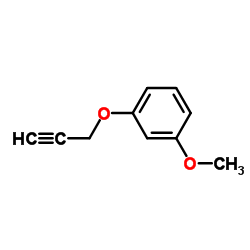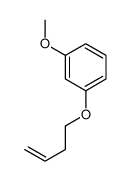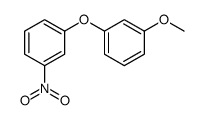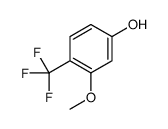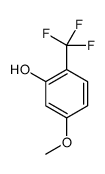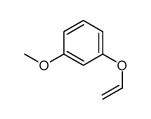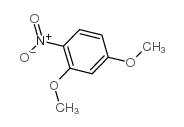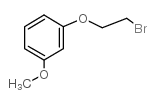150-19-6
| Name | 3-methoxyphenol |
|---|---|
| Synonyms |
m-Hydroxyanisole
Resorcinol methyl ether m-Guaiacol 3-methoxy phenol 1-Hydroxy-3-methoxybenzene 3-Methoxy-phenol Resorcinol monomethyl ether 1,3-dihydroxybenzene monomethyl ether Phenol,3-methoxy m-Hydroxyanisol 3-Methoxyphenol m-Methoxyphenol 3-hydroxyanisole EINECS 205-754-6 methyl resorcinol MFCD00002267 |
| Description | 3-Methoxyphenol is a phenolic compound that is biologically toxic. 3-Methoxyphenol is systemically absorbed, disrupts the function of the liver, kidneys, central nervous system, and redox processes, and increases levels of Hb, red blood cells, and white blood cells in the body. |
|---|---|
| Related Catalog |
| Density | 1.1±0.1 g/cm3 |
|---|---|
| Boiling Point | 244.3±0.0 °C at 760 mmHg |
| Melting Point | -17 °C |
| Molecular Formula | C7H8O2 |
| Molecular Weight | 124.137 |
| Flash Point | 119.1±4.8 °C |
| Exact Mass | 124.052429 |
| PSA | 29.46000 |
| LogP | 1.51 |
| Vapour Pressure | 0.0±0.5 mmHg at 25°C |
| Index of Refraction | 1.535 |
| Storage condition | Store in dark! |
| Water Solubility | slightly soluble |
Synonym:m-Hydroxyanisol Section 2 - COMPOSITION, INFORMATION ON INGREDIENTS
Risk Phrases: 20/21/22 36 Section 3 - HAZARDS IDENTIFICATION EMERGENCY OVERVIEW
Harmful by inhalation, in contact with skin and if swallowed. Irritating to eyes. Potential Health Effects Eye: Causes severe eye irritation. Skin: May cause skin irritation. Harmful if absorbed through the skin. May cause skin discoloration. Ingestion: May cause irritation of the digestive tract. May be harmful if swallowed. Inhalation: May cause respiratory tract irritation. Chronic: Chronic exposure may cause visual disturbances. Section 4 - FIRST AID MEASURES Eyes: Immediately flush eyes with plenty of water for at least 15 minutes, occasionally lifting the upper and lower eyelids. Get medical aid immediately. Skin: Get medical aid. Immediately flush skin with plenty of water for at least 15 minutes while removing contaminated clothing and shoes. Ingestion: If victim is conscious and alert, give 2-4 cupfuls of milk or water. Never give anything by mouth to an unconscious person. Get medical aid. Inhalation: Remove from exposure and move to fresh air immediately. Get medical aid if cough or other symptoms appear. Notes to Physician: Section 5 - FIRE FIGHTING MEASURES General Information: As in any fire, wear a self-contained breathing apparatus in pressure-demand, MSHA/NIOSH (approved or equivalent), and full protective gear. Extinguishing Media: Water or foam may cause frothing. Use water spray, dry chemical, carbon dioxide, or chemical foam. Section 6 - ACCIDENTAL RELEASE MEASURES General Information: Use proper personal protective equipment as indicated in Section 8. Spills/Leaks: Absorb spill with inert material (e.g. vermiculite, sand or earth), then place in suitable container. Section 7 - HANDLING and STORAGE Handling: Wash thoroughly after handling. Use only in a well-ventilated area. Do not get in eyes, on skin, or on clothing. Keep container tightly closed. Avoid ingestion and inhalation. Storage: Store in a tightly closed container. Store in a cool, dry, well-ventilated area away from incompatible substances. Section 8 - EXPOSURE CONTROLS, PERSONAL PROTECTION Engineering Controls: Use adequate ventilation to keep airborne concentrations low. Exposure Limits CAS# 150-19-6: Russia: 0.5 mg/m3 TWA Personal Protective Equipment Eyes: Wear appropriate protective eyeglasses or chemical safety goggles as described by OSHA's eye and face protection regulations in 29 CFR 1910.133 or European Standard EN166. Skin: Wear appropriate protective gloves to prevent skin exposure. Clothing: Wear appropriate protective clothing to prevent skin exposure. Respirators: Follow the OSHA respirator regulations found in 29 CFR 1910.134 or European Standard EN 149. Use a NIOSH/MSHA or European Standard EN 149 approved respirator if exposure limits are exceeded or if irritation or other symptoms are experienced. Section 9 - PHYSICAL AND CHEMICAL PROPERTIES Physical State: Liquid Color: clear pink red Odor: Odor of caramel and phenol pH: Not available. Vapor Pressure: Not available. Viscosity: Not available. Boiling Point: 243 - 246 deg C @ 760.00mm Hg Freezing/Melting Point: -17 deg C Autoignition Temperature: Not available. Flash Point: > 112 deg C (> 233.60 deg F) Explosion Limits, lower: Not available. Explosion Limits, upper: Not available. Decomposition Temperature: Solubility in water: soluble in water Specific Gravity/Density: 1.1310g/cm3 Molecular Formula: C7H8O2 Molecular Weight: 124.14 Section 10 - STABILITY AND REACTIVITY Chemical Stability: Stable under normal temperatures and pressures. Conditions to Avoid: Incompatible materials. Incompatibilities with Other Materials: Bases - acid chlorides - acid anhydrides - oxidizing agents. Hazardous Decomposition Products: Carbon monoxide, carbon dioxide. Hazardous Polymerization: Will not occur. Section 11 - TOXICOLOGICAL INFORMATION RTECS#: CAS# 150-19-6: SL7524000 LD50/LC50: CAS# 150-19-6: Draize test, rabbit, eye: 5% Severe; Draize test, rabbit, eye: 100%; Draize test, rabbit, skin: 100%; Inhalation, mouse: LC50 = 11500 mg/m3/4H; Inhalation, rat: LC50 = 11500 mg/m3/4H; Oral, mouse: LD50 = 312 mg/kg; Oral, mouse: LD50 = 312 mg/kg; Oral, rat: LD50 = 597 mg/kg; Oral, rat: LD50 = 597 mg/kg; Skin, rat: LD50 = 682 mg/kg. Carcinogenicity: 3-METHOXYPHENOL - Not listed by ACGIH, IARC, or NTP. Other: See actual entry in RTECS for complete information. Section 12 - ECOLOGICAL INFORMATION Section 13 - DISPOSAL CONSIDERATIONS Dispose of in a manner consistent with federal, state, and local regulations. Section 14 - TRANSPORT INFORMATION IATA Not regulated as a hazardous material. IMO Not regulated as a hazardous material. RID/ADR Not regulated as a hazardous material. Section 15 - REGULATORY INFORMATION European/International Regulations European Labeling in Accordance with EC Directives Hazard Symbols: XN Risk Phrases: R 20/21/22 Harmful by inhalation, in contact with skin and if swallowed. R 36 Irritating to eyes. Safety Phrases: S 23 Do not inhale gas/fumes/vapour/spray. S 24/25 Avoid contact with skin and eyes. WGK (Water Danger/Protection) CAS# 150-19-6: No information available. Canada CAS# 150-19-6 is listed on Canada's NDSL List. CAS# 150-19-6 is listed on Canada's Ingredient Disclosure List. US FEDERAL TSCA CAS# 150-19-6 is listed on the TSCA inventory. SECTION 16 - ADDITIONAL INFORMATION N/A |
CHEMICAL IDENTIFICATION
HEALTH HAZARD DATAACUTE TOXICITY DATA
|
| Symbol |


GHS05, GHS06 |
|---|---|
| Signal Word | Danger |
| Hazard Statements | H302 + H332-H311-H315-H318 |
| Precautionary Statements | P280-P305 + P351 + P338-P312 |
| Personal Protective Equipment | Eyeshields;Faceshields;full-face respirator (US);Gloves;multi-purpose combination respirator cartridge (US);type ABEK (EN14387) respirator filter |
| Hazard Codes | Xn:Harmful; |
| Risk Phrases | R20/21/22;R36/37/38 |
| Safety Phrases | S26-S36/37/39 |
| RIDADR | UN 2810 6.1/PG 3 |
| WGK Germany | 3 |
| RTECS | SL7524000 |
| Packaging Group | III |
| Hazard Class | 6.1 |
| HS Code | 29095090 |
| Precursor 10 | |
|---|---|
| DownStream 10 | |
| HS Code | 2909500000 |
|---|---|
| Summary | 2909500000 ether-phenols, ether-alcohol-phenols and their halogenated, sulphonated, nitrated or nitrosated derivatives VAT:17.0% Tax rebate rate:9.0% Supervision conditions:none MFN tariff:5.5% General tariff:30.0% |
